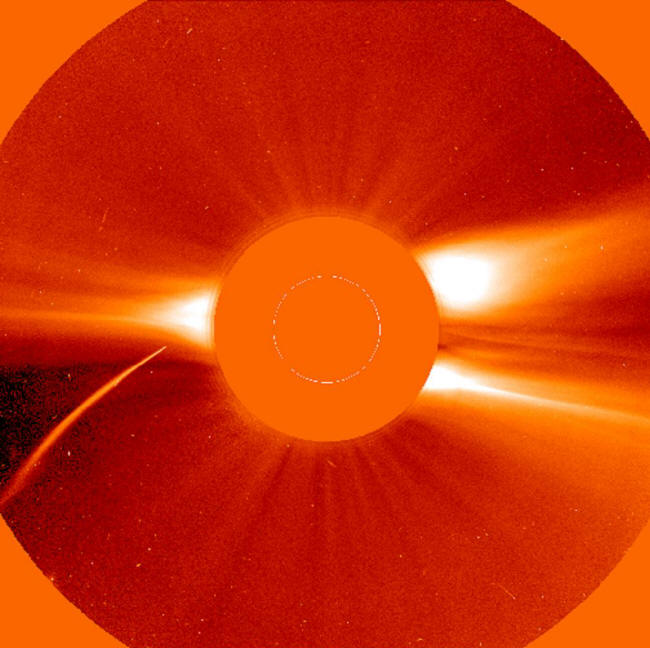Sungrazers
Nov
19, 2009
Some comets fly in close to the
Sun and then loop back into the
outer reaches of the Solar System,
with unusual results.
Comets are described as "dirty
snowballs" by the astronomical
community, despite images returned
from space probes such as Giotto and
Deep Impact that show them to have
blackened, cratered, and fractured
surfaces. No snowy fields, high
albedo crust, clouds of water vapor,
or other indications of icy
conditions have been observed. In
fact, Giotto's
close approach to Halley's comet
revealed it to be the blackest
object ever seen, with isolated
energetic plumes erupting out of a
dense nucleus.
The Deep Impact mission encountered
comet Tempel 1 in June 2005, and
launched a projectile designed to
strike the surface with the force of
an artillery shell. While research
team members at the time wondered if
they would see anything of note,
Electric Universe theorist
Wal Thornhill predicted several
results that subsequently proved
correct, validating his ideas about
the electrical nature of comets.
Tempel 1 was thought to correspond
with the conventional theory of
comet evolution. Comets are supposed
to be cold remnants from the
primordial nebular cloud out of
which the Solar System is theorized
to have condensed. They are said to
be "leftovers" that did not
consolidate into large planetary
bodies, so they remain orbiting the
Sun at a distance of several billion
kilometers in perpetual deep freeze.
The remote sphere of debris is
occasionally perturbed by a passing
planetoid or a wandering star,
whereupon several of the fragments
lose their orbital equilibrium and
begin to fall inward toward the Sun.
As they gain proximity to solar
radiant emissions they heat up,
which causes their icebound surfaces
to sublimate, forming a coma that is
gradually pushed back by the solar
wind. The elongated coma forms a
tail.
However, Tempel 1 resembled an
asteroid more than anything else. A
large crater, boulders, and cliffs
were plainly visibleónothing like
the prevailing theory of snowballs
and steam vents. Although water was
discovered in the comet's
environment, there was far too
little ice on the surface to account
for it.
Other comets have defied convention,
as well. Shoemaker-Levy 9 exploded
into shards when it crossed
Jupiter's powerful magnetosphere,
but the freshly broken pieces did
not expel any of the volatile
compounds astronomers hoped to see.
When Deep Space 1 flew by comet
Borrelly in 2001 it was found to be
hot and dry instead of cold and wet.
The Stardust mission to comet Wild 2
discovered a great deal of dust
nearby, but no trace of water could
be found on its surface.
Sungrazers tend to reaffirm the
Electric Universe opinion about
comets. If comets are the remains of
electrical events that took place
early in the life of the Solar
System, then their "anomalous"
behavior can be easily explained.
Since there is a radial electric
field from the Sun permeating the
Solar System, as comets come closer
to its greater charge density they
experience a breakdown in their
electrical equilibrium and begin to
glow. The charged material, or
plasma sheath, surrounding the
cometary nucleus is accelerated out
and away, sometimes forming a tail
millions of kilometers long.
The increased electric charge that
comets accumulate as they near the
Sun is demonstrated by sungrazers.
Since the Sun's e-field is a dynamic
structure, it changes in strength
and size depending on the electric
currents flowing into it from the
galaxy. It is in a state of constant
flux, requiring only a small trigger
for it to discharge violently. Such
discharges are known as solar flares
or coronal mass ejections (CME).
Comet NEAT swung
close by the Sun in 2003,
apparently initiating a CME eruption
that appeared to impact the comet.
Astronomers at the time discounted
any relationship between the two
events because of the size
differential between the comet and
the Sun. However,
several other sungrazers have
been associated with violent flares.
One event can be a coincidence, two
can be long odds, but three or more
can not be dismissed as mere
oddities.
When comet 96P/Machholz circled the
Sun, it came so close that if it
were composed of ice with a small
percentage of rock and dust it would
have certainly disintegrated. It did
not rapidly dissipate, however.
Instead, its intense charge
differential caused a
gigantic CME to discharge from
the Sun, blasting out for millions
of kilometers.
The electrical connection between
comets and the Sun seems certain. If
that is the case, then the
electrical connection between the
Sun and its entire family of planets
and moons is certain. Changes in
solar input and output can affect
the environments of every member in
that family: weather, orbits,
magnetic fields, and surface
features. Climate change, for
example, rather than being an
anthropic phenomenon, is doubtless
an aspect of the electrical
connection between Earth, the Sun,
and the galaxy.
Stephen Smith
|







